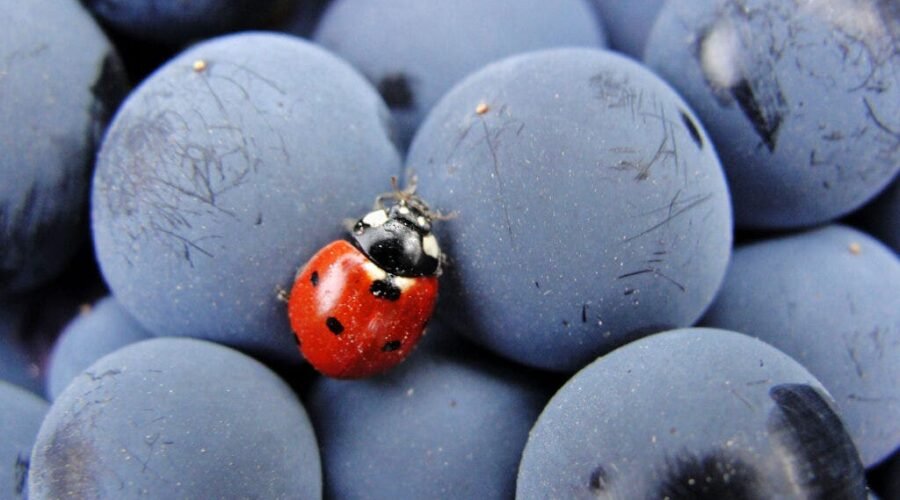Culture: How to Spot Ladybug Taint, a Downright Gross Wine Flaw
Any seasoned drinker can catch a corked bottle. It’s easy to flag if a wine has spent too much time in the sun or too long stored incorrectly. Faulted wines deliver specific muted aromas, oxidative notes or Sherry characteristics. (In some cases, they just plain stink.) But can you taste if a vineyard was overrun with ladybugs?
While ladybugs may seem innocuous, winemakers know better. The presence of these beetles in the vineyard can completely upend a wine’s quality, bringing out notes of peanut shells, rotten coconuts and green beans. Though relatively rare, it can be slightly vegetal in mild cases and earthy, musty and downright awful at the worst. The little bugs are so potent that as little as one or two ladybugs per liter—often pulled into the batch by hiding in grape clusters—can alter a batch.
When ladybug taint happens, it can spell disaster: In 2001, one million liters of wine from Ontario, Canada, was dumped following an infestation of Asian ladybug beetles.
Last month in Chianti, I was reminded of this event when tasting several wines from different Radda producers. All had unmistakable notes of rancid ballpark peanuts—a particularly jarring experience for me, as I’m allergic to peanuts. The culprit? A ladybug infestation in a small pocket of the area.
Here’s everything to know about the havoc this vineyard pest can wreak.
What Is Ladybug Taint?
Ladybug taint is a wine fault caused by vineyard-dwelling ladybugs (Coccinellidae beetles) that enter the winemaking process, typically by riding into the press via clusters of harvested fruit.
When the bugs are in distress—drowning in a large tank of wine will cause such a thing—or crushed, the bugs emit compounds called alkyl-methoxypyrazines, a smelly chemical usually used to deter predators or attract mates.
“This chemical is in the pyrazine family, which, interestingly, is also a main aromatic compound in green bell peppers, as well as grape varieties like Cabernet Sauvignon, Sauvignon Blanc and Cabernet Franc,” explains Alex Ring, sommelier at the Michelin-starred restaurants Sepia and Proxi in Chicago. In those wines, pyrazines add notes of cut grass, green bell pepper and jalapeño. However, “the ladybug version tends to be a bit more unpleasant,” he says, delivering aromas of rotten peas, moldy potatoes and aggressively nutty notes of toasted ballpark peanuts.
You May Also Like: The Science Behind the Main Wine Aromas, Explained
How to Spot Ladybug Taint
“Ladybug taint has some unique aromatic and flavor descriptors,” says Sarah Trubnick, wine director and co-founder of The Barrel Room in San Francisco. Though it can be a little confusing to pinpoint when found at very low levels due to its herbaceousness—think notes of green bell pepper and asparagus—there are some telltale signs. “The key factor to distinguish ladybug taint from other issues is the odd peanut butter or burnt walnut flavor and aroma that accompanies this herbaceousness,” she explains.
Pyrazines have a low sensory detection threshold, so as little as 1.9 beetles per kilogram of grapes can cause ladybug taint to surface (though this level will depend on grape varieties and processing methods). In large amounts, however, ladybug taint is overwhelming and unmistakeable.
All this said, ladybug taint remains rare. It’s only found during periods when ladybugs thrive, typically years with lots of bright heat and moisture. But once tasted, it’s hard to forget.
“I typically encounter at least one or two examples of ladybug-tainted wine when judging wine competitions,” says Trubnick, adding that she’s recently detected it in some wines “from the south of France and the American East coming from the 2020 and 2021 vintages.”
“My first memory of ladybug taint was with Burgundy in 2004,” recalls Matt Stamp, sommelier and co-founder of Napa’s Compline Wine Shop. “It was a green vintage, for sure, but one that some winemakers blamed on bugs rather than the wet, cool year.” He recalls tasting glass after glass of “flat, bitter, green” Burgundy with notes that were overly vegetative, raspy and dank.
“The 2004 and 2011 harvests in Burgundy were notorious for their green, stemmy characteristics,” adds Ring. “Many people believe these were caused by ladybug taint.”
For Deeper Reading: Why Your Red Wine Tastes Green
Can Ladybug Taint Be Remedied?
Though devastating in the bottle, this unsavory characteristic can be prevented both through work in the vineyard and in the winery. First and foremost, “keeping damaged fruit out of the vineyard before harvest can help prevent ladybug taint in the must,” says Trubnick, adding that integrated pest management techniques can help keep the beetles at bay. In the winery, destemming and hand sorting the grapes as they come in from the vineyard, though laborious, can help suss out ladybugs hiding in clusters.
“Certain yeasts can be used that will produce byproducts that overwhelm ladybug taint molecules,” Trubnick continues. “Fining can also be used to get rid of as much of the taint as possible.”
Of course, some contamination may be inevitable. “When you have literal tons of fruit that gets pressed and turned into hundreds or thousands of gallons of juice and you are working outside, bugs, bees, birds and lots of other critters will be attracted,” says Felicia Jefferson, wine and service director at The Duck & The Peach in Washington, D.C. “Sometimes those critters get mixed into the wine. That’s just winemaking!”
Last Updated: October 11, 2023


